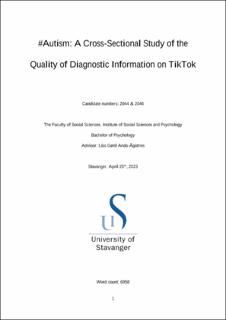| dc.contributor.advisor | Anda-Ågotnes, Liss Gøril | |
| dc.contributor.author | Jensen, Iselin | |
| dc.contributor.author | Hellevik Borgen, Vilde | |
| dc.date.accessioned | 2023-06-23T15:51:18Z | |
| dc.date.available | 2023-06-23T15:51:18Z | |
| dc.date.issued | 2023 | |
| dc.identifier | no.uis:inspera:144958821:145396664 | |
| dc.identifier.uri | https://hdl.handle.net/11250/3072940 | |
| dc.description.abstract | TikTok is one of the most popular social media applications worldwide. In this study, we aimed to investigate the quality of diagnostic information about Autism Spectrum Disorder (ASD) on TikTok. Although the amount of research on this topic is lacking, previous studies indicate that the quality of diagnostic information on TikTok is questionable. We conducted a cross-sectional content analysis, searching for the hashtag #Autism on TikTok and analyzing the 100 most liked videos. The videos were classified into three categories: misleading (M), personal experience (P) or useful (U). Results showed that 34% of the videos were misleading, 61% were personal experience, and 5% were useful. None of the videos were created or published by healthcare providers (HCPs). Lastly, there was a clear pattern in frequently highlighted ASD symptoms discussed on the application. Thus, it is important for clinicians and other HCPs to be aware of the dissemination of health misinformation on social media, as well as the potential impact this might have on clinical care. | |
| dc.description.abstract | TikTok is one of the most popular social media applications worldwide. In this study, we aimed to investigate the quality of diagnostic information about Autism Spectrum Disorder (ASD) on TikTok. Although the amount of research on this topic is lacking, previous studies indicate that the quality of diagnostic information on TikTok is questionable. We conducted a cross-sectional content analysis, searching for the hashtag #Autism on TikTok and analyzing the 100 most liked videos. The videos were classified into three categories: misleading (M), personal experience (P) or useful (U). Results showed that 34% of the videos were misleading, 61% were personal experience, and 5% were useful. None of the videos were created or published by healthcare providers (HCPs). Lastly, there was a clear pattern in frequently highlighted ASD symptoms discussed on the application. Thus, it is important for clinicians and other HCPs to be aware of the dissemination of health misinformation on social media, as well as the potential impact this might have on clinical care. | |
| dc.language | eng | |
| dc.publisher | uis | |
| dc.title | #Autism: A Cross-Sectional Study of the Quality of Diagnostic Information on TikTok | |
| dc.type | Bachelor thesis | |
